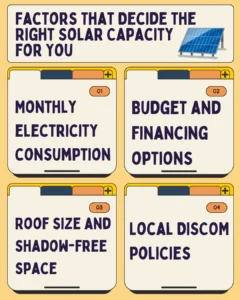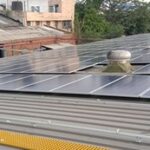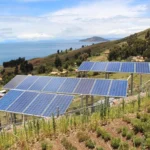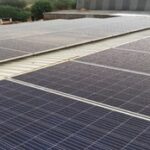Sanctioned Load & Rooftop Solar: Everything You Need to Know
Sanctioned Load & Rooftop Solar: Everything You Need to Know
Rooftop solar is becoming one of the most practical solutions for cutting electricity bills and moving toward clean energy. But before installing solar, one important factor often overlooked is the sanctioned load of your electricity connection. This value directly decides how much solar you can install on your rooftop and whether you are eligible for net metering and government subsidies.
In this blog, we’ll explain what sanctioned load means, why it matters, and the factors you need to consider before choosing your solar capacity. We’ll also share simple examples for both households and commercial setups so you can make the right decision.
What Is Sanctioned Load in Electricity Bills?
The sanctioned load is the maximum amount of power your electricity distribution company (DISCOM) has officially approved for your home or business. This is mentioned clearly on your electricity bill and is expressed in kilowatts (kW).
For example, if your sanctioned load is 5kW, it means you can use appliances together up to 5kW of power without penalty. If you exceed this limit often, DISCOM may ask you to increase your sanctioned load, which may also raise your fixed charges.
The sanctioned load helps DISCOMs manage power distribution in an area. It ensures that your home or office does not draw more electricity than the infrastructure can safely handle. For solar installation, this sanctioned load acts as a cap on the solar capacity you can install, especially if you want to apply for net metering.
Why Sanctioned Load Matters for Rooftop Solar
When you plan rooftop solar, your solar plant’s capacity must be equal to or less than your sanctioned load. This rule is followed across India as per DISCOM regulations.
For example, if your sanctioned load is 3kW, you can only install up to a 3kW solar plant under net metering. If you want to install a higher capacity, you must first apply to your DISCOM to increase your sanctioned load.
Why this matters:
Approval for net metering – DISCOM will only approve your solar setup if it matches your sanctioned load.
Eligibility for subsidy – Under schemes like the PM Surya Ghar: Muft Bijli Yojana, the sanctioned load directly affects how much subsidy you get.
Billing accuracy – Exceeding the sanctioned load can increase fixed charges and affect overall savings.
So, before planning solar, it’s essential to check your current sanctioned load and decide whether you need an upgrade.
Factors That Decide the Right Solar Capacity for You

Choosing the right solar capacity is not just about the sanctioned load. Here are the major factors that play a role:
Monthly electricity consumption
Look at your last 6–12 months of bills. If your average monthly usage is 400 units, you might need around a 3kW system. Higher consumption, like 1000+ units, will need 7-10kW or more.
Roof size and shadow-free space
A 1kW system requires about 100 sq. ft. of space. If your roof doesn’t have enough area, you may have to choose a smaller system.
Budget and financing options
Even if your sanctioned load allows for higher capacity, your budget might limit the actual installation size. Subsidies, loans, and financing help bridge this gap.
Local DISCOM policies
Some DISCOMs have upper limits for residential solar, like 10kW or 20kW, regardless of sanctioned load.
Future electricity needs: If you plan to buy an EV or add more appliances, consider increasing your sanctioned load and installing a larger system for long-term benefit.
All these factors together give you a practical solar size, ensuring you save maximum on bills while staying compliant.
How to Check Your Sanctioned Load in India
Checking your sanctioned load is simple and can be done in a few ways:
- Electricity bill – Most DISCOM bills mention “Sanctioned Load” or “Contract Demand” on the front page. For example, BSES in Delhi, BESCOM in Karnataka, and UHBVN in Haryana all include this detail.
- DISCOM mobile apps/portals – Many state DISCOMs now have apps where you can log in with your CA number to view sanctioned load and other details.
- Visit or call your DISCOM office – If your bill doesn’t mention it, you can directly ask the nearest office.
Example: If your bill says sanctioned load = 5 kW, and your average consumption is around 600 units per month, you can go for a 5kW system without worrying about net metering approval issues.
It’s always better to confirm this before applying for solar installation, as incorrect load details may delay your application.
Matching Solar Capacity With Sanctioned Load
Now, how do you match your solar system size with your sanctioned load?
- If the sanctioned load is 2-3kW: You can install up to a 3kW rooftop solar system. This usually supports households with 300–400 units per month, running fans, lights, fridge, TV, and one AC.
- If the sanctioned load is 5kW: You can install up to 5kW solar, which can support medium homes with 600-800 units/month, powering multiple ACs, geysers, and larger appliances.
Suppose the sanctioned load is 10kW+. Suitable for large houses or commercial spaces with high consumption (1000-1500 units/month). A 10kW solar plant can significantly cut bills and even support EV charging.
In case your solar requirement is higher than your sanctioned load, you must apply for a sanctioned load increase at your DISCOM. The process is straightforward but involves additional charges.
Government Rules and Net Metering Guidelines
Net metering is closely tied to sanctioned load. According to most state DISCOM policies in 2025:
- Solar capacity must be less than or equal to the sanctioned load.
- Residential systems are usually capped at 10kW to 20kW, even if the sanctioned load is higher.
- Commercial and industrial users may get approvals up to 100% of the sanctioned demand.
- Subsidy under PM Surya Ghar Yojana is only applicable if the sanctioned load matches your applied solar system size.
For example, Haryana DISCOMs allow rooftop solar up to the sanctioned load, but not exceeding 500kW for a single connection, under net-metering. In Delhi, the state subsidy for residential rooftop solar is capped, with the highest benefit available for systems up to 3 kW.
Checking your state’s solar policy is a must before applying, and a trusted solar installer like Smart Roof Solar helps handle this process end-to-end.
Practical Example: Household vs. Commercial Sanctioned Load
Let’s take two quick scenarios:
- Household: A family in Haryana has a sanctioned load of 5kW. Their average monthly bill is 700 units. Installing a 5kW system fits perfectly with their sanctioned load and can cut their bills by up to 80%.
- Commercial shop: A small business in Delhi has a sanctioned load of 20kW and a monthly usage of 2500 units. They can install up to a 20kW system, which not only reduces bills but also provides faster ROI compared to households.
In both cases, the sanctioned load sets the upper limit. Without matching it, DISCOM will reject net metering applications.
Plan Smart, Install Right
Sanctioned load may seem like a technical detail, but it plays a major role in deciding your rooftop solar system size, approvals, and subsidy eligibility. Whether you are a homeowner or a business, checking and aligning your solar system with your sanctioned load ensures smoother installation and faster savings.
At Smart Roof Solar, we don’t just install solar panels – we guide you through the entire process, from checking the sanctioned load to approvals, subsidies, and final setup. Ready to go solar the smart way? Contact Smart Roof Solar today and make the switch to clean, cost-saving energy.
FAQs
Q1. What happens if I install more solar than my sanctioned load?
Ans: DISCOM may reject your net metering application or disconnect the excess system from the grid.
Q2. Is there a penalty for exceeding the sanctioned load without approval?
Ans: DISCOMs may impose penalties or higher fixed charges if you consistently exceed it.
Q3. Can I reduce my sanctioned load later if I install energy-efficient appliances?
Ans: Yes, you can apply to lower your sanctioned load, but it may take some time to process.
Q4. Can two tenants in the same building share a sanctioned load?
Ans: No, each meter or connection has its own sanctioned load; it cannot be shared across units.
Q5. How often can I change my sanctioned load?
Ans: There’s no strict limit, but DISCOMs usually allow changes once or twice a year based on need.
Suggested Articles

Sustainable Solar Panel Disposal: Recycling for a Greener Future
Sustainable solar panel disposal ensures old or damaged panels are recycled responsibly, reducing waste and environmental harm. By adopting eco-friendly recycling and reuse practices, we can recover valuable materials, lower carbon impact, and make solar energy truly sustainable from installation to end-of-life.

How Azimuth Angle Impacts Solar Panel Efficiency for Homes, Industries, and Commercial Buildings
Discover how solar panel azimuth impacts energy generation in homes, industries, and commercial buildings. Maximize efficiency with correct orientation.

SECI Sets Record in Renewable Energy Trading, Surpasses ₹100 Billion
SECI achieves record renewable power trading revenue surpassing ₹100 billion, marking a milestone in India’s clean energy growth and solar market expansion.

Net Metering and its Advantages
Net Metering allows solar panel owners to feed excess electricity back to the grid and earn credits, reducing energy bills. Learn the key advantages of net metering for homes and businesses.

Save on Electricity in Haryana Using Net Metering: A Complete Guide
Learn how to save on electricity in Haryana with net metering. Step-by-step guide on benefits, installation, and cost savings for your home or business

Top 10 Sustainable Building Practices to Consider for Your Construction Business
The construction industry is embracing sustainability like never before. From smart design to renewable energy use, these top 10 practices ensure businesses stay competitive, compliant, and environmentally responsible.

India’s Solar Capacity Growth Slows Down in Q1 2023
India’s solar capacity growth slowed in Q1 2023. Explore the factors behind the slowdown and its impact on the country’s renewable energy progress.

Solar Panel Selection Demystified: How to Choose the Right Panels for Solar Installation
Choosing the right solar panels can be confusing with so many options in the market. This guide simplifies solar panel selection by comparing types, efficiency ratings, and cost factors. Whether for your home, business, or industry, learn how to make an informed decision and maximize the return on your solar investment.